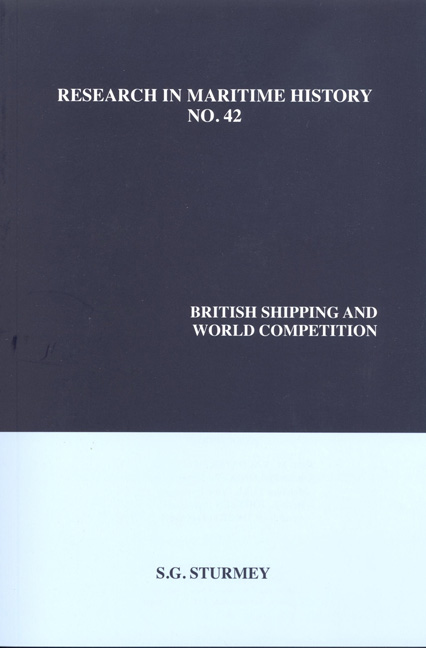Book contents
- Frontmatter
- Table of Contents
- Series Editor's Foreword
- About the Author
- Preface
- Figures and Tables
- Chapter 1 The Problem Defined
- Chapter 2 High Water: The Pre-1914 Period
- Chapter 3 War and Reconstruction
- Chapter 4 The Troubled Years: The Interwar Period
- Chapter 5 Nationalism in Shipping in the Interwar Years
- Chapter 6 The Birth of the Liberty
- Chapter 7 The Prosperous Age: The Postwar Period
- Chapter 8 Enemies of Competition in the Postwar Years
- Chapter 9 Flags of Convenience
- Chapter 10 Economics of Shipping Enterprises
- Chapter 11 Shipowning and Resource Allocation
- Chapter 12 Labour Relations and Labour Costs (by Basil Mogridge)
- Chapter 13 The Conference System
- Chapter 14 The Structure of the British Industry
- Chapter 15 The Question Answered
- Epilogue The Future
- Appendix The Contribution of British Shipping to the Balance of Payments
- Bibliography
- Index
Chapter 14 - The Structure of the British Industry
- Frontmatter
- Table of Contents
- Series Editor's Foreword
- About the Author
- Preface
- Figures and Tables
- Chapter 1 The Problem Defined
- Chapter 2 High Water: The Pre-1914 Period
- Chapter 3 War and Reconstruction
- Chapter 4 The Troubled Years: The Interwar Period
- Chapter 5 Nationalism in Shipping in the Interwar Years
- Chapter 6 The Birth of the Liberty
- Chapter 7 The Prosperous Age: The Postwar Period
- Chapter 8 Enemies of Competition in the Postwar Years
- Chapter 9 Flags of Convenience
- Chapter 10 Economics of Shipping Enterprises
- Chapter 11 Shipowning and Resource Allocation
- Chapter 12 Labour Relations and Labour Costs (by Basil Mogridge)
- Chapter 13 The Conference System
- Chapter 14 The Structure of the British Industry
- Chapter 15 The Question Answered
- Epilogue The Future
- Appendix The Contribution of British Shipping to the Balance of Payments
- Bibliography
- Index
Summary
The structure of the British industry in 1960 is set out in table 14.1. As the table shows, eight large liner groups between them owned over eighty percent of all British liner tonnage, in addition to some tramp and tanker tonnage. The ownership of the tramp fleet is well dispersed, with a few large fleets and many small ones. The tanker fleet is owned mainly by the oil companies, the remainder being owned independently by shipowners as such. In this chapter it will be most convenient first to comment briefly on the ownership of tramps and tankers and then to discuss at greater length the ownership of liners.
Ownership of Tankers and Tramps
Of the British tanker fleet, nearly four million tons is owned by the oil companies themselves. The oil companies were originally forced into shipowning because of the unwillingness of shipowners at the end of the nineteenth century to invest in such revolutionary craft as tankers. Indeed, it was not until after the First World War that the world independent tanker fleet became significant and not until after the Second World War that the British independent fleet became important.
Independent shipowners own just over 1.25 million tons of the British tanker tonnage. The largest tanker owners are Mavroleon and Kulukundis, and Hunting and Son; both also own tramp ships and bulk carriers. Mr. Mavroleon has been a shipowner in Britain for a number of years in the well-established pattern of what are usually known as the London-Greeks. These people, resident in London and often British subjects when of the second generation, begin as shipbrokers and ship managers. Many then acquire one or two tramp ships on their own account, or own a share in each of the ships which they manage. The Messrs. Kulukundis are Greeks, resident in New York. The two companies which are included in table 14.1 are Counties Ship Management and London and Overseas Freighters. The first of these is a management company formed in 1936 and managing ships owned by a large number of mainly sin gle-ship companies. These companies, in their turn, are owned mainly by Greek interests, resident either in Greece or in London. Mavroleon after the war saw the opportunity to build up a fleet of independently-owned tankers and in 1947 placed orders for two 16,000-deadweight ton tankers.
- Type
- Chapter
- Information
- British Shipping and World Competition , pp. 301 - 320Publisher: Liverpool University PressPrint publication year: 2009

